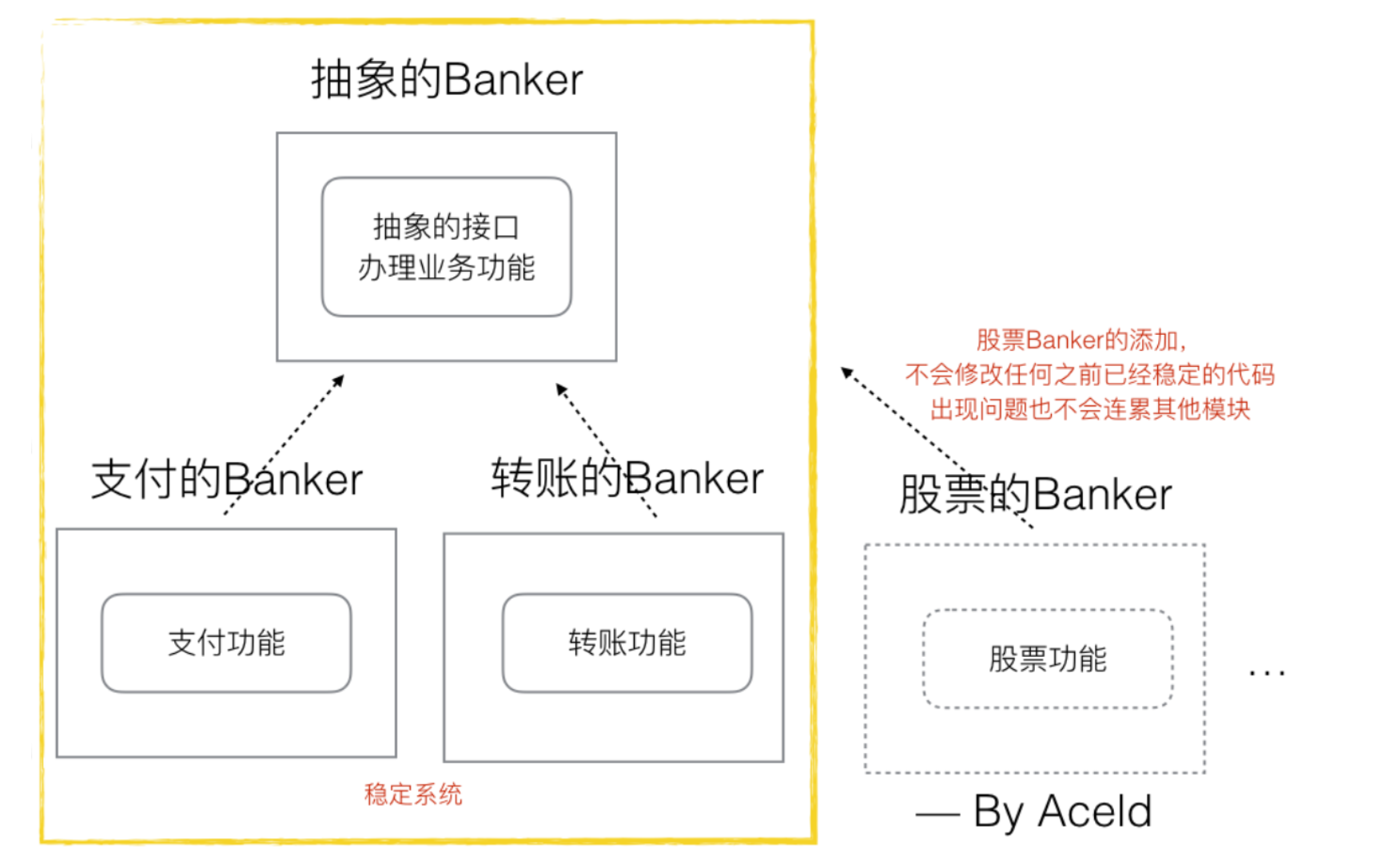第3节 开闭原则
❤️💕💕Java和Golang的设计模式,设计模式介绍、创建者模式、结构型模式、行为型模式。Myblog:http://nsddd.top
[TOC]
原则
警告
开闭原则 (Open-Closed Principle, OCP)
类的改动是通过增加代码进行的,而不是修改源代码。
没有使用开闭原则
💡简单的一个案例如下:
// The principle of opening and closing
// Path: 79-main.go
package main
import (
"fmt"
)
// The principle of opening and closing
type Banker struct {
}
// Deposit business
func (b *Banker) Deposit() {
fmt.Println("存款成功")
}
// Withdrawal business
func (b *Banker) Withdraw() {
fmt.Println("取款成功")
}
// Transfer business
func (b *Banker) Transfer() {
fmt.Println("转账成功")
}
func main() {
b := &Banker{}
b.Deposit()
b.Withdraw()
b.Transfer()
}
需求:我们需要加一个股票功能,我们需要额外添加功能。
注意
但是我们类可能看不出来,如果一个类很庞大,添加功能的时候就需要特别小心。
这就是设计的弊端。
那么,如果我们拥有接口, interface这个东西,那么我们就可以抽象一层出来,制作一个抽象的Banker模块,然后提供一个抽象的方法。 分别根据这个抽象模块,去实现支付Banker(实现支付方法),转账Banker(实现转账方法)

提示
那么即使 Banker 的添加,不会修改 任何已经稳定的代码,出现问题也不会连累其他模块。
// 开闭原则
package main
import "fmt"
// 抽象的银行接口
type Banker interface {
Deposit() //存款
Withdraw() //取款
Transfer() //转账
}
// 实现银行接口
type Bank struct {
}
// 存款
func (b *Bank) Deposit() {
fmt.Println("存款成功")
}
// 取款
func (b *Bank) Withdraw() {
fmt.Println("取款成功")
}
// 转账
func (b *Bank) Transfer() {
fmt.Println("转账成功")
}
// 我们可以再定义一个支付宝的银行接口
type Alipay struct {
}
// 存款
func (a *Alipay) Deposit() {
fmt.Println("支付宝存款成功")
}
// 取款
func (a *Alipay) Withdraw() {
fmt.Println("支付宝取款成功")
}
func main() {
b := &Bank{} //实现了接口
b.Deposit()
b.Withdraw()
b.Transfer()
a := &Alipay{}
a.Deposit()
a.Withdraw()
}
注意
Alipay{} 结构体并不是需要去实现接口。所以作为扩展性。
实现架构层,基于抽象层业务封装
提示
实现一个架构层,基于抽象层进行业务封装,针对 interface 进行封装。
// The principle of opening and closing
package main
import "fmt"
//Abstract bank interface
type Banker interface {
Deposit() //deposit
Withdraw() //Withdrawal
Transfer() //Transfer
}
//Implement the bank interface
type Bank struct {
}
//deposit
func (b *Bank) Deposit() {
fmt.Println("存款成功")
}
//Withdrawal
func (b *Bank) Withdraw() {
fmt.Println("取款成功")
}
//Transfer
func (b *Bank) Transfer() {
fmt.Println("转账成功")
}
//We can define another Alipay bank interface
type Alipay struct {
}
//deposit
func (a *Alipay) Deposit() {
fmt.Println("支付宝存款成功")
}
//Withdrawal
func (a *Alipay) Withdraw() {
fmt.Println("Alipay withdrawal successful")
}
//Transfer
func (a *Alipay) Transfer() {
fmt.Println("Alipay transfer successful")
}
//Implement an abstraction layer to isolate the different implementation layers so that new implementation layers can be added without modifying the original code, which is the open-close principle
func BankBusiness(bank Banker) {
bank.Deposit()
}
func main() {
//The business of deposits
BankBusiness(&Bank{})
BankBusiness(&Alipay{})
}
🚀 编译结果如下:
[Running] go run "d:\文档\最近的\awesome-golang\docs\code\go-super\80-main.go"
存款成功
支付宝存款成功
END 链接
✴️版权声明 © :本书所有内容遵循CC-BY-SA 3.0协议(署名-相同方式共享)©